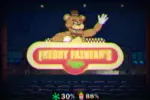It all started in 2014 with a computer game about a security guard. He was tasked with monitoring four haunted animatronic characters and managing his power for six hours to prevent them from reaching his office and killing him. It sounds simple enough for a horror game, right? Well, the answer is both yes and no.
Simple Games
It can be easy to simply write off Five Nights at Freddy’s as a collection of simple horror strategy games, and that’s OK. Most of the games use the game mechanic of fending off crazed robots, which has challenged and thrilled strategy gamers for six years.
That’s really all games need in order to be successful in the gaming industry, but the series has always been a bit more than simple survival games. Even the first game included arcade, platformer-like minigames that also dropped hints about the lore. In six short years, the FNAF universe has become so much more than a collection of horror games.
Complicated Lore
It’s pretty much common knowledge by now that the FNAF franchise has an extremely complicated story behind it. In a nutshell, it involves children, murder and a whole lot of purple. Clues to the lore are often subtle, like news clipping and audio files in the first game.
In recent years, creator Scott Cawthon has become much bolder with his storytelling. He created nine books to entertain readers with his horror stories, which remain largely independent of the games’ timelines.
Of course, few people know the complicated lore of the series better than The Game Theorists, and it’s through their efforts that the real potential of the series begins to reveal itself. It’s largely a matter of perspective.
The Theories
Ever since the first FNAF game was released in 2014, The Game Theorists — MatPat especially — have taken the games and the books and put them all under a microscope.
MatPat has scoured the games and picked apart every tiny detail — every little hint — and has been putting them together in an effort to build definitive timelines to the books and games. Now he has 38 theory videos to show for his efforts, and more will be made in time. That alone shows the devotion the FNAF series can inspire from its followers.
The Game Theorists focus on more than just lore, however. Gaijin Goomba has also analyzed the horror aesthetics of the games and what makes them so effective or ineffective. His findings showed that horrifying experiences in childhood determine one’s susceptibility to certain aspects of horror in adulthood.
Their understanding of the series enriches our own, and through them, we receive the theorists’ perspective on the series. To be completely fair, there have been plenty of other theorists spread throughout the internet, but The Game Theorists are easily some of the most well-known. However, The Game Theorists are only one piece to the puzzle in the FNAF series’ success.
An Explorative Fandom
Beyond the books, games and theories, the FNAF series takes on a life of its own through its fans. Fan-made music videos surrounding the FNAF series are all over YouTube, The Living Tombstone being a popular example.
The songs made by fans expose the series to rock, metal and pop. The FNAF games don’t include much music, so the exposure the series has gotten to musical genres by the fans is nothing short of remarkable.
Simulated Firsthand Experience
Within the world of animation, anything is possible. Across YouTube, many animators can be found honing their craft with resources like Source Filmmaker and providing their own takes on the FNAF universe.
Some of them, like Junior 0437, use animation to create fan-made VHS recordings of band performances at Freddy Fazbear’s Pizzeria, often with hints of the hauntings that would have been taking place behind the scenes. They provide perspective into what it might have been like to experience FNAF series horror stories firsthand if they actually occurred in the real world.
Expanding Personalities
Before Sister Location was released in 2016, the animatronics never officially spoke, so the only indication of personalities was their murderous intentions toward the player. Although they were sympathetic characters, the animatronics were still the enemies of the games.
Nonetheless, this didn’t stop fans from giving their own take on what thoughts were in the animatronics’ robotic heads. David Near provided fan voices for the animatronics, although canon ones emerged in time.
The Outsider Looking In
Some fans, like j-gems, took the idea of providing voices for FNAF animatronics one step further by animating interviews. These interviews provided a bit of background into the struggles of their troubling existence as well as their reactions to it.
Through the interviews, we see the series through the perspective of an outsider looking in, receiving little more than a glimpse into what makes the animatronics tick.
The Creator’s Commitment
It can be concluded that Scott Cawthon is the most responsible for the FNAF series’ success and continued expansion. After all, he is the creator. He created the FNAF games and the books. Despite the fans’ tremendous success at pushing the FNAF universe into new territory, they were working with Cawthon’s source material the whole time.
One of the big secrets to FNAF’s continued success is simply that Cawthon has continued to make games long after anyone could have reasonably expected him to. Many forms of media end after a trilogy, but he has persisted, releasing game after game and then book after book, continuing to deepen and complicate the lore to keep fans hooked.
The fans can and will likely continue to use their innovative ways to take the FNAF universe in new directions, but in the end, it is thanks to Scott Cawthon’s efforts that the series continues.
















